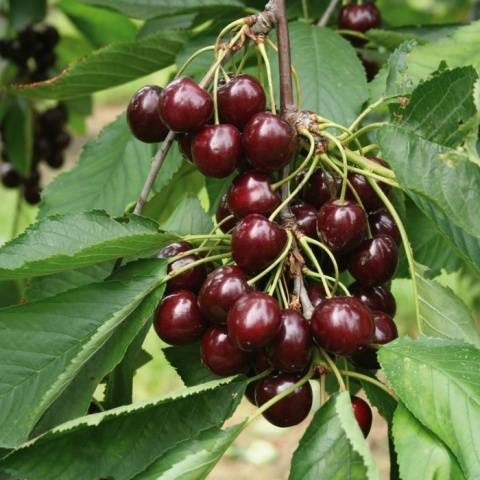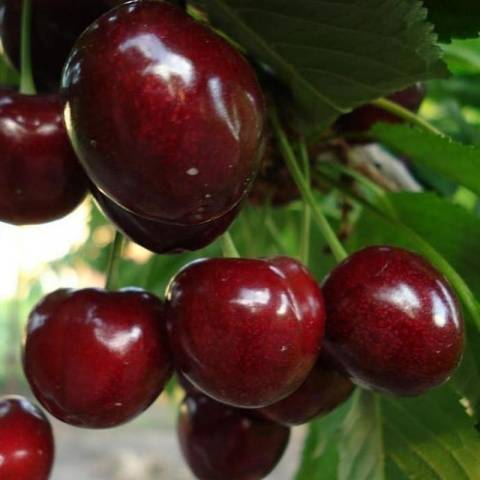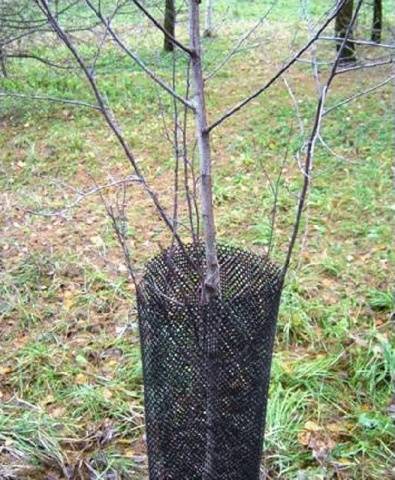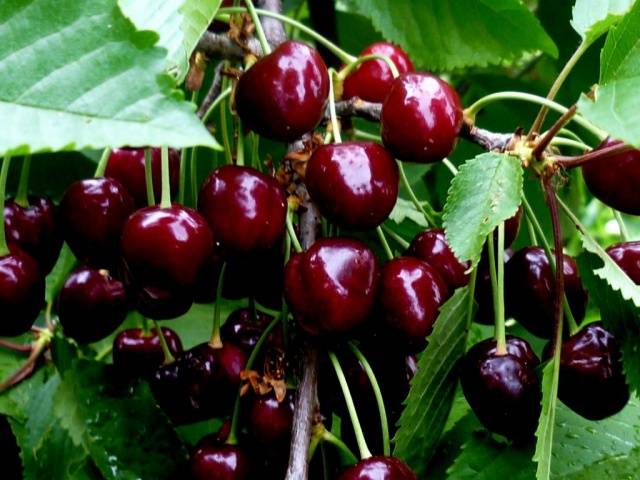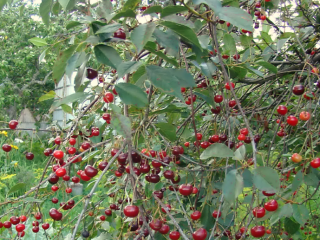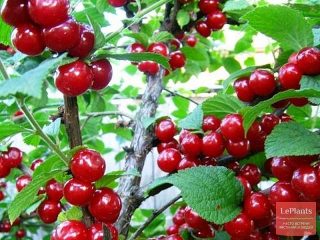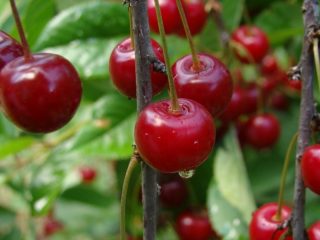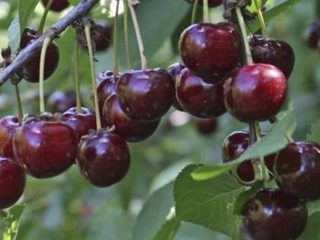Content
The dwarf cherry is compact in size and produces a high, decent harvest. One of the best varieties is Vstrecha, which bears tasty fruits and has a high immunity.
Breeding history
Cherry Vstrecha bred by Ukrainian breeders Nikolai and Valentina Turovtsevs. When working on it, a cherry-cherry hybrid Kievskaya-19 and a late-ripening cherry Lyubskaya were used.
The hybrid was received in 1966. Since 1995, information about the Meeting has been present in the state register of varieties of Ukraine.
Description of culture
Features of Hybrid Meeting:
- bushy type of tree;
- height from 2 to 2.5 m;
- wide, dense crown in the shape of a ball;
- drooping shoots.
Variety Meeting is a natural dwarf. The advantages of dwarf varieties are compactness, easy maintenance and high yield. The cherry bush has a lush crown, quickly takes root and grows after planting.
Characteristics of the fruits of the Vstrecha variety
- large sizes;
- weight 15 g;
- rounded, slightly flattened shape;
- thin burgundy skin;
- juicy and tender red pulp;
- the stone is medium in size.
The fruits have a dessert taste. One of the parent varieties is a hybrid of cherry and sweet cherry, so there are cherry notes in the taste. Taste is rated 5 points out of 5.
Cherry pulp has a high sugar content (11.6%). In terms of marketability and taste, the fruits are close to the reference varieties Miracle and Shokoladnitsa.
Variety Vstrecha is recommended for planting in steppe regions. In temperate and cool climates, the tree develops slowly and does not bear fruit.
Characteristics
When choosing a cherry, take into account its resistance to drought, frost, diseases and pests. If necessary, select a pollinator variety.
Drought resistance, winter hardiness
Hybrid Meeting has good drought resistance and is able to tolerate lack of moisture. To increase yields, it is recommended to water the tree during flowering and at the beginning of fruiting.
Winter hardiness of the Vstrecha variety is rather low. The tree tolerates winter frosts down to -25 ° C.
Pollination, flowering period and ripening times
The flowering variety Vstrecha falls on the end of April or the beginning of May. The variety is partially self-fertile. Planting pollinators is required to obtain a high yield.
The best pollinators for the Encounter hybrid are dwarf varieties that bloom at the same time. Planted next to the tree cherry Lyubskaya, Perceptible, Samsonovka, Minx.
Harvesting begins at the end of June. The fruits stay on the branches for a long time after ripening.
Productivity, fruiting
Fruiting varieties Vstrecha begins 3-4 years after planting a seedling. The crop ripens on one-year-old shoots.
The yield of the variety is high - about 25 kg of fruits per bush. Fruiting is stable from year to year. The average life of a tree is 20 years, after which the planting is replaced.
Scope of berries
Cherry Meeting due to its dessert taste is suitable for fresh consumption and preparation of desserts. The fruits tolerate transportation and freezing well. A variety of homemade preparations are obtained from it: jams, compotes, juices, marshmallows.
Disease and pest resistance
Resistance of cherries The encounter with diseases and pests is estimated at an average level. The tree is immune to moniliosis and coccomycosis.
An obligatory step in the care is to carry out preventive treatments. Fungal diseases, which spread at high humidity, are especially dangerous for the tree.
Advantages and disadvantages
Main Benefits of Cherry Meeting:
- high productivity;
- easy care due to the low growth of cherries;
- quickly begins to bear fruit;
- commercial and taste qualities of fruits.
The disadvantages of the Vstrecha variety include:
- the need to plant a pollinator;
- average frost resistance;
- exactingness to climatic conditions.
Landing features
Cherries are planted in a prepared area. Be sure to take into account the composition of the soil and crops growing in the immediate vicinity of the hybrid.
Recommended timing
For planting, the period from mid-September to October is suitable. When planting in autumn, the cherry will have time to take root before the onset of cold weather.
It is allowed to postpone planting work in the spring (mid-April or early May). Planting begins after warming up the soil, but before the buds swell.
Choosing the right place
The place for growing cherries must meet a number of requirements:
- good lighting;
- no wind loads;
- drained fertile soil.
Cherries prefer flat areas where their roots are not exposed to moisture. Therefore, lowlands and slopes are not suitable for planting.
Light fertile soil is best suited for planting: loam or sandy loam of a neutral reaction. Lime is added to the acidified soil in 2-3 weeks of work.
What crops can and cannot be planted next to cherries
Hybrid Meeting well tolerates the neighborhood of other varieties of cherries and various shrubs:
- cherries;
- thorn, plum, cherry plum;
- grapes;
- elder;
- hawthorn;
- honeysuckle;
- Rowan.
The exception is sea buckthorn, gooseberries, raspberries and currants. The hybrid is removed from other shrubs by 1.5-2 m.
Cherry Meeting is planted away from the following crops:
- apple tree, pear;
- peach, apricot;
- oak, maple, linden, birch;
- coniferous trees;
- tomato, pepper and other nightshades.
Tall trees create shade, and their roots take a lot of nutrients from the soil. The permissible distance between cherries and other trees is from 5 to 6 m.
Selection and preparation of planting material
For planting, choose two-year-old seedlings with a height of 50-60 cm. The seedling must have healthy roots and shoots without damage.
4 hours before the start of work, the roots of the seedling are dipped into clean water, to which a corner growth stimulator is added.
Landing algorithm
The sequence of works on planting the Vstrecha variety:
- The soil in the selected area is dug up.
- Then prepare a pit 50 cm in size and 40 cm deep.
- The pit is left for 3-4 weeks for the soil to shrink. For spring planting, it is better to prepare a pit in the fall.
- Add to the fertile soil: 50 g of superphosphate, 30 g of potassium sulfate and 1 kg of wood ash. The components are thoroughly mixed, part of the soil is placed in a pit.
- The cherry is planted in a pit, its roots are straightened and covered with the remaining earth.
- The soil is well compacted.
- The seedling is watered abundantly with water.
Follow-up care of the culture
Dwarf cherries are pruned before or after the start of sap flow. 5-10 strongest shoots are left for each bush. Be sure to remove dry, broken and frozen branches.
Hybrid Meeting is enough to water 3-5 times per season. Moisture is required for the shrub during the flowering stage and at the beginning of fruiting. 2-3 liters of water are poured under the bush.
To prepare the meeting cherry for winter, its trunks are spud and the soil is mulched with humus. A young seedling is covered with a net or roofing material to protect it from rodents, and in winter, a snowdrift is thrown over it.
Diseases and pests, methods of control and prevention
Despite the resistance of the hybrid Meeting to disease, under certain conditions, signs of damage may appear on the tree.
Common diseases that cherries are susceptible to are shown in the table:
Disease | Symptoms | Control measures | Prophylaxis |
Moniliosis | First, the shoots and leaves of the cherry dry up. Then gray growths appear and the fruits rot. | The affected parts of the tree are cut and destroyed. Cherries are sprayed with Bordeaux liquid or Kuprozan. |
|
Cocomycosis | The appearance of round brown spots on the leaves. As a result, leaves fall, and the shrub dies. | Spraying with Bordeaux liquid or copper oxychloride. | |
Anthracnose | Brown spots on the surface of the fruit that grow rapidly. | Removal of affected fruits and spraying the bush with Poliram. |
In the table, the main pests of cherries are indicated:
Pest | Signs of defeat | Control measures | Prophylaxis |
Aphid | It feeds on the juice of young leaves. The pest is identified by twisted leaves. | Spraying with solutions with Phosphamide or Fitoverm. |
|
Weevil | Eats ovaries, gnaws holes in the leaves. | Spraying with insecticides Fufanon, Actellik. | |
Sawfly | The larvae eat the top layer of the leaves, which begin to fall off. | Spraying with Kemifos. |
Conclusion
Hybrid Meeting perfectly tolerates hot climate conditions. The variety is distinguished by its high yield and dessert taste of the fruit.
Testimonials

